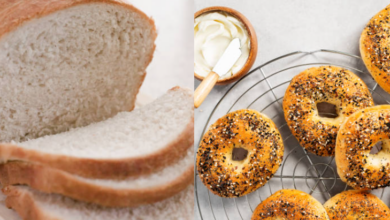White Bread Vs Pumpernickel Bread: The Ultimate Taste Test
What To Know
- It also boasts a wealth of vitamins and minerals, including iron, magnesium, and B vitamins, making it a healthier choice for those seeking a nutritious bread option.
- White bread’s mild flavor and soft texture make it a crowd-pleaser, while pumpernickel bread’s bold flavor and dense texture appeal to those seeking a more robust bread experience.
- While you can substitute white bread with pumpernickel bread in some recipes, the denser texture and stronger flavor of pumpernickel bread may alter the overall taste and texture of the dish.
In the realm of bread, two contenders stand tall, each with its unique charm and flavor profile. White bread, the quintessential choice for sandwiches and toast, and pumpernickel bread, the dark horse with a distinctive sour tang, have sparked debates among bread enthusiasts for ages. While both have their merits, the question remains: which one reigns supreme? Let’s embark on a culinary journey to unravel the mysteries of these two bread titans.
Appearance and Texture: A Visual and Tactile Comparison
White bread, as its name suggests, boasts a pristine white crumb and a soft, fluffy texture that yields easily to the touch. Its airy nature makes it a perfect canvas for spreads and toppings, allowing the flavors to shine through. Pumpernickel bread, on the other hand, commands attention with its dark, almost black crumb, a result of the rye flour and molasses used in its creation. Its texture is denser and chewier, providing a satisfying bite that pairs well with robust flavors.
Taste and Aroma: A Sensory Exploration
White bread exudes a mild, slightly sweet flavor that appeals to a wide range of palates. Its neutral taste makes it a versatile choice for a variety of culinary applications, from sandwiches to French toast. Pumpernickel bread, in contrast, possesses a distinct sour tang that some find intriguing and others find off-putting. Its robust flavor profile, reminiscent of molasses and roasted coffee, makes it an excellent accompaniment to strong cheeses, smoked meats, and pickled vegetables.
Nutritional Value: A Tale of Two Profiles
White bread, made primarily from refined wheat flour, offers a moderate amount of carbohydrates and protein. However, its nutritional value is often criticized due to its low fiber content and lack of essential vitamins and minerals. Pumpernickel bread, on the other hand, shines in the nutritional arena. Its high fiber content aids in digestion and promotes a feeling of fullness. It also boasts a wealth of vitamins and minerals, including iron, magnesium, and B vitamins, making it a healthier choice for those seeking a nutritious bread option.
Culinary Applications: A Journey Through Recipes
White bread’s versatility extends beyond sandwiches and toast. Its mild flavor and soft texture make it ideal for croutons, bread crumbs, and stuffing. It also serves as a base for various sweet treats, such as bread pudding and French toast. Pumpernickel bread, with its bold flavor and dense texture, excels in open-faced sandwiches, Reuben sandwiches, and hearty soups. Its distinct sourness adds a unique dimension to salads and canapés.
Health Considerations: A Balancing Act
White bread, due to its high glycemic index, can cause spikes in blood sugar levels, making it less suitable for individuals with diabetes or prediabetes. Pumpernickel bread, with its lower glycemic index, is a better choice for those seeking a more stable blood sugar response. However, its high fiber content may cause digestive discomfort in some individuals.
Key Points: A Matter of Personal Preference
The white bread vs pumpernickel bread debate is a matter of personal preference, with each bread offering unique characteristics and culinary applications. White bread’s mild flavor and soft texture make it a crowd-pleaser, while pumpernickel bread’s bold flavor and dense texture appeal to those seeking a more robust bread experience. Ultimately, the choice between these two bread titans depends on your taste preferences, nutritional needs, and culinary intentions.
Frequently Asked Questions:
1. Is white bread healthier than pumpernickel bread?
Pumpernickel bread generally has a lower glycemic index and higher fiber content compared to white bread, making it a healthier choice for some individuals.
2. Is pumpernickel bread good for weight loss?
Pumpernickel bread’s high fiber content can promote a feeling of fullness and may aid in weight management. However, it’s important to consider your overall diet and lifestyle for effective weight loss.
3. Can I substitute white bread with pumpernickel bread in recipes?
While you can substitute white bread with pumpernickel bread in some recipes, the denser texture and stronger flavor of pumpernickel bread may alter the overall taste and texture of the dish.
